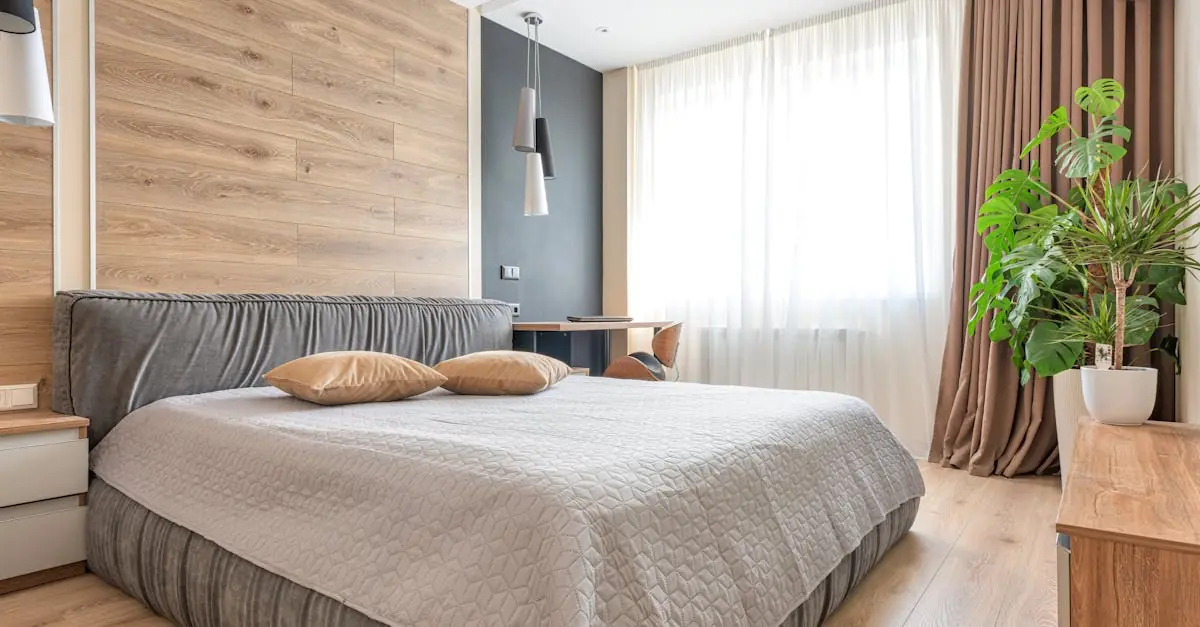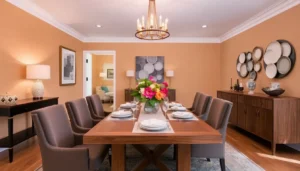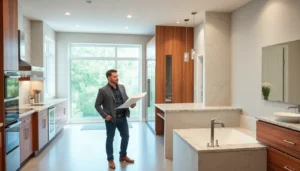Imagine sinking into a cozy couch surrounded by a clean, airy space that feels as inviting as a warm hug on a chilly day. That’s the magic of Scandinavian interior design. It’s not just about aesthetics; it’s a lifestyle that embraces simplicity, functionality, and a touch of hygge.
In a world overflowing with clutter and chaos, Scandinavian design offers a refreshing escape. Think sleek lines, muted colors, and natural materials that whisper elegance without shouting for attention. Whether you’re a design aficionado or just looking to spruce up your living room, this style promises to transform your space into a serene sanctuary. So, grab a cup of coffee, kick back, and let’s explore how to infuse your living room with that effortlessly chic Scandinavian vibe.
Table of Contents
ToggleOverview of Scandinavian Interior Design
Scandinavian interior design embodies a lifestyle centered around simplicity, functionality, and comfort. Key characteristics include clean lines, muted color palettes, and a focus on natural materials. Emphasis on minimalism creates a serene atmosphere, contrasting sharply with the chaos of modern life.
This design style prioritizes practicality, ensuring that every element serves a purpose. Furniture pieces often feature sleek designs and multifunctional capabilities. For example, a sofa may transform into a bed, maximizing space without sacrificing style.
Color schemes predominantly consist of whites, grays, and soft earth tones. These shades promote a calm, inviting environment. Incorporating textures, such as wool throws or wooden accents, adds warmth and character to living spaces.
Natural light plays a vital role in Scandinavian design. Large windows enable sunlight to flood the room, fostering a connection between indoors and outdoors. When designing a living room, choosing sheer curtains can enhance this natural brightness.
Art and decor showcase simplicity and craftsmanship. Artwork typically reflects nature or abstract forms, adding visual interest without overwhelming the space. Integrating plants further instills a sense of tranquility, bringing the outdoors inside.
Sustainability is also a significant factor. Many Scandinavian designers prioritize eco-friendly materials and practices. Choosing responsibly sourced wood or recycled textiles contributes to a more sustainable living environment.
Overall, Scandinavian interior design creates a harmonious balance of beauty and functionality. It encourages individuals to cultivate a serene space that nurtures relaxation and well-being.
Key Elements of Living Room Scandinavian Interior Design
Scandinavian design revolves around essential elements that create a serene living room atmosphere. Emphasis on simplicity and functionality marks each component.
Color Palette
Whites, grays, and soft earth tones dominate the color palette, creating a calm environment. Light shades enhance space, making rooms feel airy and bright. Adding pops of muted colors can bring warmth without overwhelming the senses. Soft pastels and nature-inspired hues often complement neutral tones, aligning with this design philosophy. Overall, the color scheme fosters tranquility and promotes relaxation.
Materials and Textures
Natural materials contribute significantly to Scandinavian design. Wood remains a staple, providing warmth and connection to nature. Textiles such as wool and linen enhance comfort and add layers to the space. Combining different textures, like a smooth wooden table with a soft, plush throw, adds visual interest without cluttering. Incorporating stone or ceramic elements introduces an earthy touch, grounding the aesthetic. These materials work together to create an inviting and harmonious environment.
Furniture Selection
Furniture selection prioritizes multifunctionality while maintaining aesthetic appeal. Sofas often convert into beds, accommodating both comfort and practicality. Clean lines characterize furniture pieces, offering a minimalist approach that avoids excess. Simple designs focus on usability, providing ample storage solutions without compromising space. Additionally, Scandinavian furniture often highlights craftsmanship, with attention to detail ensuring durability. Each item contributes to a well-balanced living room that promotes relaxation and functionality.
Lighting in Scandinavian Living Rooms
Lighting plays a pivotal role in Scandinavian living rooms, enhancing the overall ambiance and functionality. Designers prioritize natural light, often using large windows to maximize brightness in the space.
Natural Light
Natural light remains essential in Scandinavian design. Expansive windows allow ample sunlight to flood living areas, fostering a warm and inviting atmosphere. Sheer curtains further enhance this effect, diffusing harsh sunlight while maintaining privacy. Utilizing mirrors also reflects light, creating an illusion of a larger space. Many spaces incorporate skylights, especially in smaller areas, enabling unobstructed light access. The focus on natural light underscores the connection to outdoors, creating a calming retreat indoors.
Light Fixtures
Light fixtures complement the natural lighting in Scandinavian living rooms. Designers often choose minimalist pendant lights and sleek floor lamps to avoid visual clutter. Soft, warm bulb hues create an inviting environment during the evening hours. Many fixtures feature clean lines and geometric shapes, further solidifying the aesthetic. Table lamps provide localized lighting, adding functionality and atmosphere to reading corners. Incorporating natural materials like wood, metal, and glass enhances the design’s cohesion while reinforcing its commitment to simplicity and craftsmanship.
Decorating Tips for a Scandinavian Living Room
Creating a Scandinavian living room involves embracing minimalism, functionality, and a connection to nature.
Minimalism and Functionality
Less is more in Scandinavian design. Focus on essential furniture pieces that serve dual purposes, such as sofa beds or coffee tables with storage. Clean lines define each item, maintaining a clutter-free environment. Prioritize comfort alongside functionality; choose ergonomic chairs and plush cushions. Each element should carry significance and contribute to a serene atmosphere. For instance, integrate a stylish bench that offers seating and storage, optimizing space. Simplistic decor, like a single piece of artwork, draws attention without overwhelming the senses. Aim for a harmonious balance between beauty and purpose in every design element.
Incorporating Nature
Nature plays a vital role in Scandinavian interiors. Embrace organic materials like wood, stone, and wool to create a warm ambiance. Selecting furniture that highlights these natural resources instills a sense of tranquility. Houseplants, such as snake plants and pothos, add greenery and improve air quality. Light curtains allow sunlight to pour in, enhancing the connection with the outdoors. Incorporating natural light enhances mood and boosts energy levels. Use earthy tones in accessories to reflect outdoor elements, fostering a seamless transition between indoor and outdoor spaces. Prioritizing nature in decor promotes wellness and a calming atmosphere.
Embracing Scandinavian interior design in the living room transforms spaces into serene retreats. The emphasis on simplicity and functionality creates an inviting atmosphere that encourages relaxation. Thoughtfully chosen materials and a muted color palette foster a sense of calm while ensuring practicality.
Incorporating natural elements and maximizing light enhances the overall aesthetic and promotes well-being. By focusing on minimalism and comfort, it’s possible to achieve a harmonious balance that reflects both beauty and purpose. This design style not only elevates the living space but also enriches daily life, making it a perfect choice for anyone seeking tranquility in their home.




